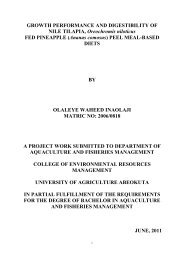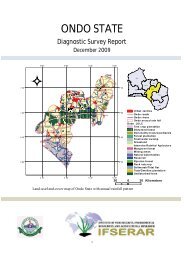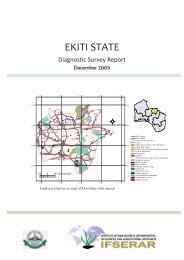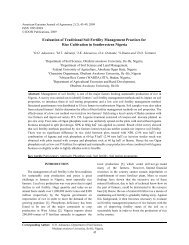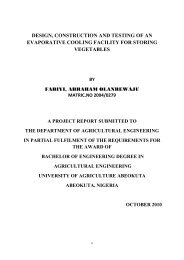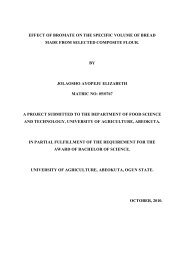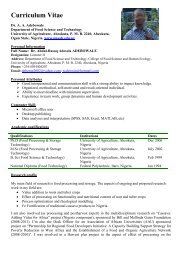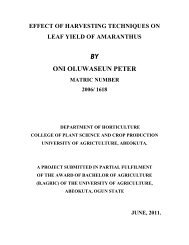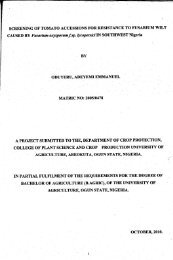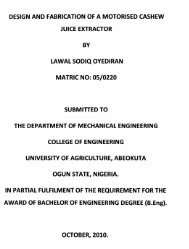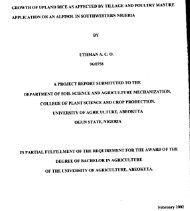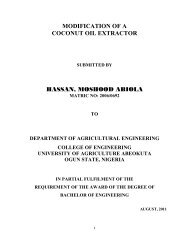MICROBIOLOGICAL AND CHEMICAL CHANGES DURING ...
MICROBIOLOGICAL AND CHEMICAL CHANGES DURING ...
MICROBIOLOGICAL AND CHEMICAL CHANGES DURING ...
Create successful ePaper yourself
Turn your PDF publications into a flip-book with our unique Google optimized e-Paper software.
<strong>MICROBIOLOGICAL</strong> <strong>AND</strong> <strong>CHEMICAL</strong> <strong>CHANGES</strong> <strong>DURING</strong> BREADFRUIT<br />
FERMENTATION<br />
BY<br />
OLAITAN, Ololade Funke (PG08/0185)<br />
B.Sc. (UNAAB, Abeokuta)<br />
A Dissertation submitted to the Department of Food Science and Technology, College of Food Science<br />
and Human Ecology, University of Agriculture, Abeokuta in partial fulfillment of the requirements for the<br />
degree of Master in Food Microbiology and Biotechnology<br />
SEPTEMBER, 2011<br />
ABSTRACT<br />
Breadfruit (Artocarpus altilis) is a perennial crop that can be processed into food and feed. Its<br />
fermentation process needs to be understood to increase its utilisation. The changes in the microbial<br />
population and chemical composition of fermenting breadfruit are investigated in this study. Freshlyharvested<br />
breadfruits were peeled, washed and divided into two equal portions longitudinally. The first<br />
portion was grated, washed, pressed in jute bags and fermented (SSF) at ambient temperature (28 ± 2 o C)<br />
for 120 h. The other portion was soaked in sterile water and fermented (SBF) at the same temperature and<br />
time. The microbial population of the SSF and SBF were enumerated and identified at 24 h intervals<br />
using morphological, cultural and biochemical tests as well as 16S rRNA sequence analysis. The changes<br />
in the pH, total titratable acidity (TTA), moisture content, total soluble sugar (TSS), total starch (TS),<br />
total reducing sugar (TRS), protein and mineral contents of the SSF and SBF were determined at 24 h<br />
intervals by standard methods while unfermented breadfruit served as control. The lactic acid bacteria and<br />
yeast counts in the SSF and SBF increased from 3.00 x 10 7 to 2.75 x 10 9 , 6.00 x 10 6 to 1.10 x 10 8 and<br />
7.00 x 10 6 to 3.00 x 10 7 , 7.00 x 10 6 to 7.00 x 10 7 cfu/g, respectively and differed significantly (p < 0.05)<br />
from the control (2.64 x 10 4 , 7.00 x 10 4 and 2.00 x 10 4 , 3.00 x 10 4 cfu/g). The dominant lactic acid<br />
bacteria identified from both SSF and SBF were Lactobacillus plantarum strain 6 and Lactobacillus<br />
pentosus while the dominating yeast was Saccharomyces cerevisiae. The pH of the SSF and SBF<br />
decreased from 4.72 to 4.26 and 5.76 to 4.65, respectively and differed significantly (p < 0.05) from the<br />
control (6.57). The TTA of the SSF and SBF increased from 0.34 to 0.80 and 0.23 to 0.62 mg/g,<br />
respectively and also differed significantly (p < 0.05) from the control (0.18 mg/g). The moisture content,<br />
Federal University of Agriculture, Abeokuta (FUNAAB)<br />
www.unaab.edu.ng<br />
Create PDF files without this message by purchasing novaPDF printer (http://www.novapdf.com)
TSS, TS and TRS of the SSF decreased from 61.98 to 49.50 %, 9.10 to 5.30 g/100g, 20.01 to 12.10<br />
g/100g and 7.92 to 4.10 µg/g, respectively and were significantly (p < 0.05) lower than the control (62.12<br />
%, 8.90 g/100g, 21.89 g/100g and 7.49 µg/g). Furthermore the TSS, TS and TRS of the SBF decreased<br />
from 9.20 to 2.10 g/100g, 20.01 to 13.69 g/100g and 7.71 to 5.42 µg/g, respectively while the moisture<br />
content increased from 63.12 to 78.62 % and were significantly (p < 0.05) higher than the control. The<br />
protein content of SSF and SBF also decreased from 6.01 to 3.98 and 5.65 to 1.94 %, respectively and<br />
significantly (p < 0.05) less than the control (5.91 %). The sodium and potassium content of SSF and SBF<br />
decreased from 4.15 to 2.67 mg/g, 11.45 to 6.19 mg/10g and 3.83 to 3.11 mg/g, 2.39 to 1.35 mg/10g,<br />
respectively and were significantly less than the control (4.51mg/g, 11.26mg). This study has established<br />
that fermented breadfruit has desirable chemical attributes while grating prior to fermentation enhances<br />
the protein and potassium content.<br />
Federal University of Agriculture, Abeokuta (FUNAAB)<br />
www.unaab.edu.ng<br />
Create PDF files without this message by purchasing novaPDF printer (http://www.novapdf.com)



